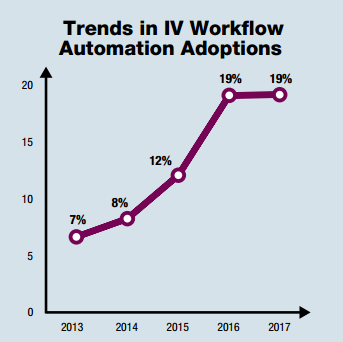Pharmacy Purchasing & Products (PP&P) puts out a survey each year called The State of Pharmacy Automation (SOPA). The 2017 PP&P SOPA is out and available for your reading pleasure.
The PP&P SOPA survey covers many automation, technology, and practice trends. One item that I look at each year with great interest is the reported IV workflow management system (IVWFMS) adoption rate. I’ve written about IVWFMS many times. I even went as far as to do a podcast dedicated to them back in 2015.*
While reviewing the 2017 SOPA numbers, I was surprised to see that this year’s survey shows no gain in adoption of IVWMS over last year. They appear to be stalled at approximately 19%, same as last year (see graph from PP&P 2017 SOPA below).

While informative, it’s important to take these survey results with a grain of salt. Response rates are incredibly low, for one thing. Results can also be skewed based on participants, i.e. it may not be the same pharmacies responding year over year. This makes it difficult to draw direct comparisons from one year to the next.Â
Regardless, I was still surprised to see the flattened curve. I expected to see a sharp uptake. Most facilities I go into these days are using, or in the process of implementing, an IVWFMS of some kind. It’s becoming less common to find a facility not using one of these systems, especially in larger facilities where they seem to be slowly becoming best practice. Â
One other item worth mentioning is my belief that last year’s survey overestimated the number of facilities using IVWFMS. So if last year was really 12-15%, perhaps this year’s result is an improvement. That’s purely speculation on my part. I have nothing concrete to back it up other than my sense of the market. Through no fault of PP&P, I feel like these surveys are a poor representation of what’s really going on in the real world.
Other takeaways from this year’s survey:
- Larger hospitals are adopting IVWFMS faster than smaller hospitals. No surprise here. If you’re a hospital with more than 400 beds and you haven’t implemented one of these systems, you’re wrong and should be embarrassed by your lack of action. “Ninety-nine percent of the failures come from people who have the habit of making excuses.” ~ George Washington Carver. Simple as that.
- DoseEdge by Baxter is the #1 system in use. Again, no surprise. This corresponds to what I see in the wild. Baxter has been in the game for a while. DoseEdge is definitely the first system that comes to mind when talking about IV room technology. Pharmacy Keeper by MedKeeper at #2 is a bit of a surprise. I have yet to go into a pharmacy that is using it. It’s a less functional system than say DoseEdge or BD Cato, but it’s also less expensive and easier to install, implement, and maintain. I personally believe pharmacies should be looking at systems with proven gravimetrics, but that’s just me. Pick your own poison.
- DoseEdge by Baxter is the #1 system under consideration for new implementations. BD Cato comes in at #2 by a small margin. DoseEdge at #1 surprises me a bit. Most facilities I go into these days have BD Cato at the top of their list of possibles, and for good reason. BD Cato has a lot to offer, especially now that they are part of CareFusion. Perhaps the survey is a bit behind what I’m seeing out in the wild. Impossible to say.
That’s it. I’m not sure that the raw numbers presented in the survey are helpful, but the information in the SOPA survey goes way beyond the numbers. For instance, the SOPA may introduce pharmacies to vendors and technologies that they’ve never heard of before. I encourage everyone to read through the PP&P 2017 SOPA. Who knows, you might find something new and exciting in there. I’ve been doing this for many years, but I still get surprised from time to time.Â
I can’t explain the SOPA survey results, but overall it feels to me that adoption of IVWFMS is still on the rise.
—–
*Looking back through some of my old posts — and the podcast — it’s amazing how little this landscape has changed.